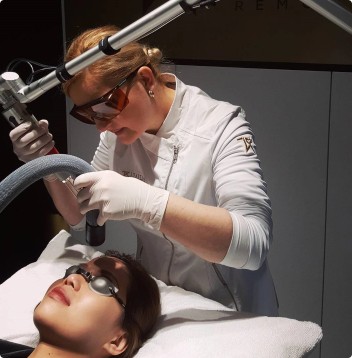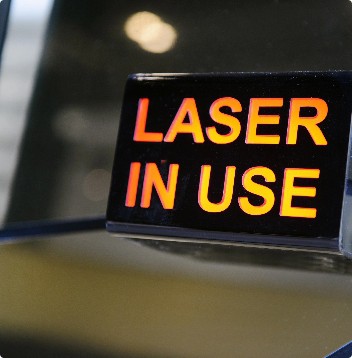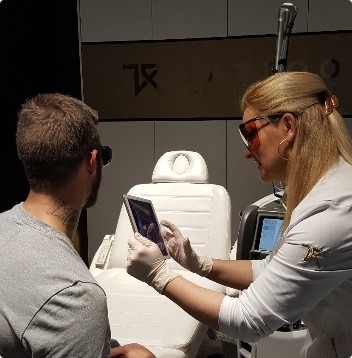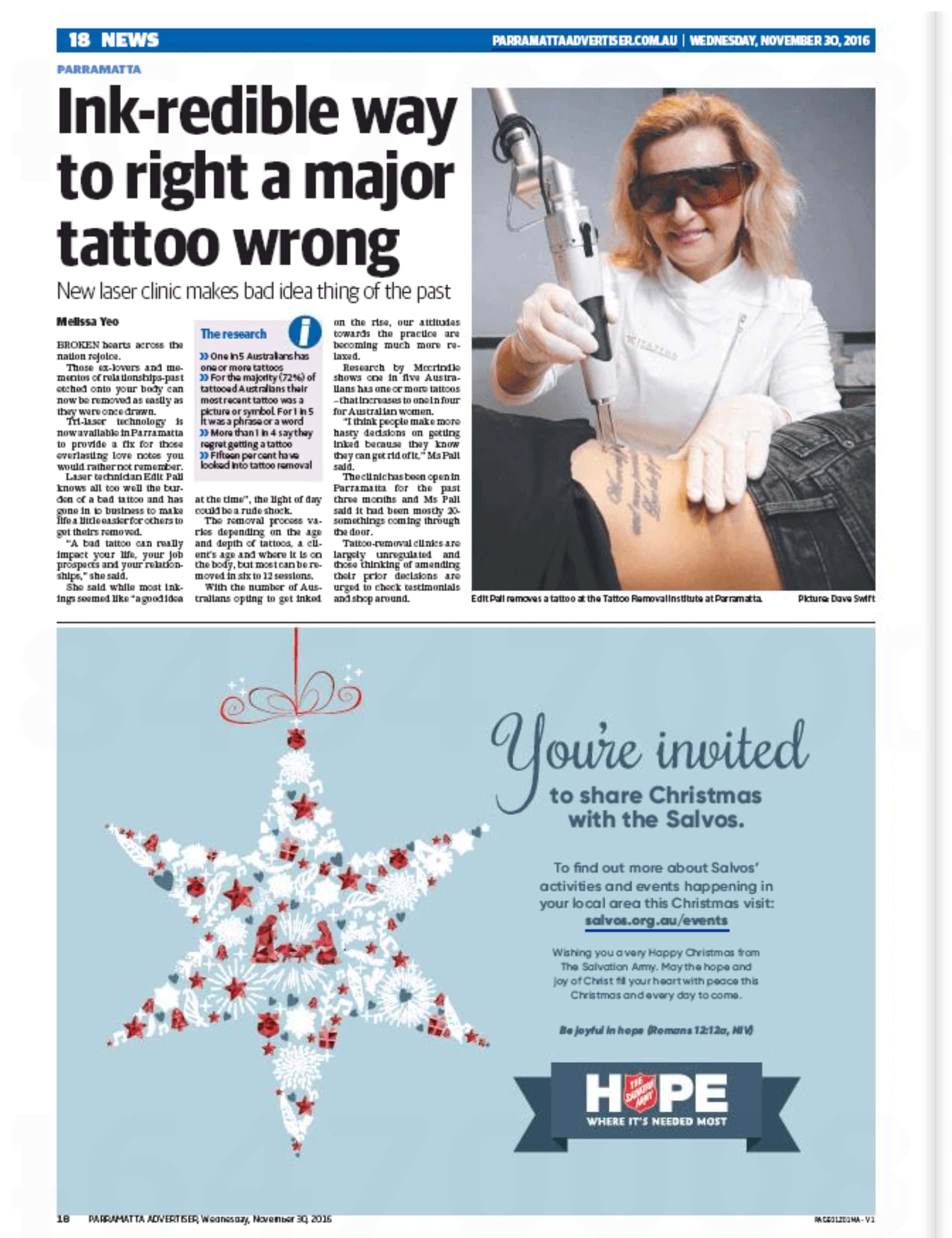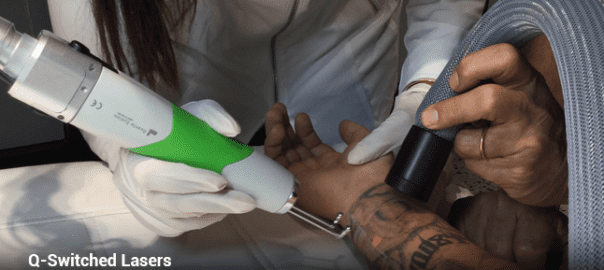While the laser tattoo removal process is proven to be the most risk-free, successful way to get rid of unwanted tattoos, it’s the aftercare, or lack thereof, that often leads to a tattoo removal infection.
Most patients will experience certain side effects that are completely normal that a laser technician will warn of and explain how to treat. If patients don’t follow these essential aftercare instructions, they could end up with bacteria in the open wound.
We hope it never has to come to this, but if it does, here’s what patients can do to treat a laser tattoo removal infection.
How To Prevent Infection After The Tattoo Removal Process
Skin gets infected when bacteria enters an open wound.
Therefore, to prevent laser tattoo removal infection, the treated skin needs to be monitored closely during the recovery process.
Things that will also help include:
- maintain a healthy diet rich in fruit and vegetables;
- drink plenty of water;
- keep the tattooed area away from the direct sun;
- not smoking.
Blistering as a Side Effect
A common side effect of laser tattoo removal is blistering. The intense heat from the laser light causes the tattoo ink particles to disintegrate, which in turn causes the surrounding blood vessels to break.
The body’s immune system responds by sending the resulting water and tattoo pigment to the skin’s surface in blisters.
Why Blistering Increases the Risk of Infection
The risk of adverse reactions comes in when the skin starts to blister (which is entirely normal). If the superficial blisters rupture, it results in an exposed area that is susceptible to bacteria and infection.
How To Deal With Blistering
Applying ice to the treatment area as soon as possible after laser removal can reduce the chance of blistering and aid the healing process.
Patients should gently wash the treated area with soap and water, dry thoroughly, and apply antiseptic ointment before bandaging. This needs to be done three times a day for three days.
How Not To Deal With Blistering
To minimise the risk of tattoo removal adverse reactions, patients should try and keep the blisters intact and not pop the blisters by themselves.
More often than not, blistering will cause an itching sensation. Scratching will lead to popping, so patients must resist the urge to scratch! Instead, they can apply Vitamin E ointment to soothe itchiness.
Other things could accidentally lead to a blister popping, such as bumping the affected area or even just sleeping on it. If patients do experience open blisters and open wounds, this is where they need to take particular care to avoid getting infections.
Patients should take care not to:
- apply make-up or cosmetic products to the treated area.
- apply moisturising lotions, only use the antibacterial ointment.
- shave the blistered area.
- take a long hot bath or swim.
- let high-pressure water hit the affected area directly.
Most patients don’t succumb to infections, but in the unfortunate event that they do, they could safely perform treatment at home by following these steps. If anything seems out of the ordinary, they should seek medical help immediately.
1) Identify the Symptoms of Infection
Side effects can occur after laser tattoo removal sessions.
The area is probably infected if those usual side effects are heightened.
The following things are expected, but the severity of the symptoms can indicate a possible tattoo removal infection.
Red Flare-up of Skin
If the skin around the actual tattoo ink area is red, swollen and warm, that is normal. Red, darkened skin, extending a much larger surface than the treatment area, can indicate infection.
Superficial Blisters Oozing
Translucent liquid oozing from blisters is normal. Yellow or green pus-like drainage is definitely an indication of infection.
Pain
Sensitive skin after laser treatment is common. Significant pain to the touch can indicate infection. Joint and muscle soreness can also indicate inflammation from infection.
2) Keep It Clean
Patients should wash their hands before working with the area so as not to get any germs involved.
They should gently wash the treated area with soap and water and pat it dry thoroughly with a clean towel.
It is important to avoid touching, fiddling with or picking the area, which could prolong the recovery and even lead to permanent scarring.
The wound should be covered with a bandage or gauze to prevent more bacteria from entering, and replaced daily.
3) Topical Treatment of a Skin Infection
Patients should apply antiseptic ointment: either continue using the one prescribed by their laser technician or get an antibacterial over the counter ointment.
Here are some options:
- Bacitracin
- Neosporin
- Hydrogen peroxide cream
- Povidone-iodine ointment
They should follow the instructions for the treatment, but still be sure to clean the area regularly to speed up the healing process.
4) Seek Medical Attention
If patients experience any of the following, especially if these symptoms persist over longer than two weeks, they should seek medical attention immediately:
- Fever
- Swelling
- Pain
- Flare-ups and redness
- Oozing pus
- Bleeding
Something to Consider About Laser Treatment
Before going ahead with the laser tattoo removal process on tattooed skin, patients must be sure to do their research first.
Although adverse reactions occur because of neglecting aftercare treatment, the institution chosen for the laser treatment plays a big part.
If the laser technician is underqualified, they might not provide proper treatment, and in a non-sterile environment. Coupled with incorrect aftercare instructions, the chance of tattoo removal infection is multiplied.
Technology is always evolving and improved versions of equipment are constantly being rolled out. Using outdated equipment and techniques could have an adverse effect.
At the Tattoo Removal Institute, we use the most advanced tattoo removal methods in the field by using the latest technology available. For example, the Two-Way Method we utilise reduces the side effects such as blistering and possible scarring.
Key Takeaways
Patients should do their research before choosing an institution to perform laser tattoo removal.
They should take note of the aftercare treatment and do it thoroughly. Neglecting to do so can cause adverse reactions.
If patients notice prolonged red flare-ups and pain, or blisters oozing pus, there is a big chance that they have a laser tattoo removal infection.
Patients should keep the infected site clean at all times, and wash their hands before handling it.
Infection can be treated with over the counter antibacterial ointments but medical attention should be immediately sought after if symptoms persist or get worse.
If patients have any questions or concerns, they can book a free, no obligations consultation with one of our specialists at the Tattoo Removal Institute. We can offer expert advice for peace of mind.
DISCLAIMER: The information contained herein should NOT be used as a substitute for the advice of an appropriately qualified and licensed physician or other health care provider. The information provided here is for informational purposes only. Please check with a physician if you have health questions or concerns about interactions or go to the TGA for a comprehensive list of TGA warnings. Although we attempt to provide accurate and up-to-date information, no guarantee is made to that effect.

